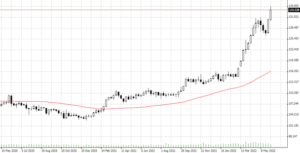

09.06.2022 – As expected, the situation with the Japanese yen has deteriorated dramatically. The currency is stuck in a downward spiral that is difficult to stop. We shed light on the background.
The dollar has just risen to 134.55 to the yen – the highest level since 2002. Former Japanese Finance Minister Eisuke Sakakibara – also known as Mr. Yen – has already brought the 150 yen per dollar mark into play. The high from 1998, by the way, is 147.66. But there’s more: the peak from 1982 is even around 280. When USDJPY – here the weekly chart – will return to the 50 line is written in the stars. Perhaps in an intervention, when Japan sells dollars.

Source: Bernstein Bank GmbH
This is what happened: Traders and investors are watching with concern as Bank of Japan (BOJ) Governor Haruhiko Kuroda spouts nothing but bubbles despite the current situation. In front of parliament in Tokyo on Wednesday, he talked up the yen’s weakness and fabricated that it was good for the economy. After all, he added, a stronger crash of the foreign currency is not desirable.
The ultimate dilemma
Which makes it clear to the financial blog Zero-Hedge that the BOJ is in a bind. The central bank can either keep the interest rate on ten-year Japan Government Bonds stable at 0.25 percent. That is its stated goal. Or it can support the yen. Both together are not possible, he said. The fact that the central bank decided in favor of the interest rate target is hardly surprising in view of the enormous indebtedness of the Nippon.
Lone Loser
A forex expert also sees it that way: Kuroda’s statements accelerated the sell-off of the yen, judged Jun Kato, Chief Market Analyst at Shinkin Asset in Tokyo. He added: “The picture of the yen being left out as a lone loser came to the fore as markets actively priced in an ECB rate hike while the Australian dollar remains on an uptrend with its clear tightening stance.”
Commodity Cross Trade
And that has already given traders an interesting clue: If Japan is the only major economy to keep interest rates low while the U.S., and soon the European Central Bank, raise rates, then short opportunities open up here. This is even more true for the yen against currencies of countries with strong commodity earnings. These include, in addition to the U.S. (gold, silver, oil, gas, coal, copper), Australia (ore, gold, lead, zinc, nickel) or Canada (gold, oil, uranium, nickel, potash salt). Commodity currencies are likely to be the winners against other countries without commodities in the current inflation – when commodity prices rise, the treasury fills up and these countries can more easily reduce their own debt. We look forward to seeing what happens next – Bernstein Bank is keeping an eye on the issue for you.
Important Notes on This Publication:
The content of this publication is for general information purposes only. In this context, it is neither an individual investment recommendation or advice nor an offer to purchase or sell securities or other financial products. The content in question and all the information contained therein do not in any way replace individual investor- or investment-oriented advice. No reliable forecast or indication for the future is possible with respect to any presentation or information on the present or past performance of the relevant underlying assets. All information and data presented in this publication are based on reliable sources. However, Bernstein Bank does not guarantee that the information and data contained in this publication is up-to-date, correct and complete. Securities traded on the financial markets are subject to price fluctuations. A contract for difference (CFD) is also a financial instrument with leverage effect. Against this backdrop, CFD trading involves a high risk up to the point of total loss and may not be suitable for all investors. Therefore, make sure that you have fully understood all the correlating risks. If necessary, ask for independent advice. CFDs are complex instruments and are associated with the high risk of losing money quickly because of the leverage effect. 68% of retail investor accounts lose money trading CFD with this provider. You should consider whether you understand how CFD work and whether you can afford to take the high risk of losing your money.7
